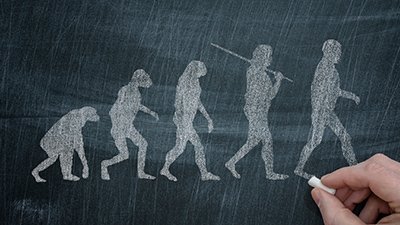Is Their Model Upright?
PhysOrg: “Bipedal Humans Came Down from the Trees . . .” “This model should cause everyone to re-evaluate what they’ve said before”—the words of a Duke University professor whose research turns the origins of bipedal walking on its head.
That professor, evolutionary anthropologist Daniel Schmitt, collaborated with postdoctoral researcher Tracy Kivell in an examination of the two dominant, opposed models of how human bipedalism (walking upright on two feet) supposedly evolved. One model considers ground-dwelling apes (specifically, gorillas) to have been at the origin of bipedalism. The other model suggests the ambulation of tree-climbing apes (specifically, chimps) gave rise to upright walking.
The evidence at the middle of the debate are the wrist and hand bones of African apes.
The evidence at the middle of the debate are the wrist and hand bones of African apes. Each camp believes the bones of their group of apes match up better with humans’, proving an evolutionary connection.
In their research, Kivell and Schmitt investigated the wrist bones of nearly 150 chimps (including bonobos) and compared the bones with those of 91 gorillas. They determined that two important skeletal features associated with knuckle-walking were found in approximately 90 percent of chimps but in only 6 percent of gorillas. Those features differentiate the two groups because of the way each knuckle-walks. Chimps keep their wrists in a more flexible, bent position, causing greater skeletal stress that necessitates the features. This flexibility is also more conducive to moving along tree limbs. Gorillas, by contrast, keep their wrists straight, causing them to walk more similarly to quadrupeds, such as elephants. Such a posture is more efficient for ground movement. Thus, the first conclusion Kivell and Schmitt make is that the two groups evolved their knuckle-walking behavior separately.
But where do humans fit in? The scientists noted that some of the features humans have in common with knuckle-walkers also exist in lemurs, which do not knuckle-walk. And since chimps are—according to some evolutionists—our closest evolutionary relatives, the features previously interpreted as evidence of knuckle walking could actually be evidence of an arboreal lifestyle.
In the paper, Kivell and Schmitt write, “Instead, our data support the opposite notion, that features of the hand and wrist found in the human fossil record that have traditionally been treated as indicators of knuckle-walking behavior in general are in fact evidence of arboreality.” Rather than a knuckle-walking phase, they believe a human ancestor went straight from swinging in the trees to walking upright on the ground.
Why all the guesswork? Unfortunately for evolutionists, “there are no fossils from the time of this transition,” a news release emphasizes, and “none of the later fossils considered to be on the direct human line were knuckle-walkers.” So what can we conclude?
- As with so many studies of evolutionary anthropology, this research is predicated on the presupposition that anatomical similarities can show evolutionary relationships. Creationists understand similarities between kinds as reflective of one Designer re-using designs in animals designed for similar habitats.
- Creationists should not be surprised that there are no fossils documenting the transition to bipedalism, or that human fossils show no legacy of knuckle-walking (except in some evolutionists’ imaginations). In fact, this study leaves us with the fanciful idea of tree-dwelling apes swinging down and suddenly walking upright on the ground; the idea is deemed “scientific” only because the researchers have disproved the alternative—thus it becomes evolutionarily necessary.
- Also of note is that the anatomical features the scientists examined weren’t present in all or none of each ape type, but rather fractions of each. Thus, even with present-day members of created kinds, there can be a range and many skeletal anomalies. Creationists should remember this when it comes to interpreting fossils, many of which are closely similar to modern humans or closely similar to modern apes with only minor distinctions.
For more information:
Remember, if you see a news story that might merit some attention, let us know about it! (Note: if the story originates from the Associated Press, Fox News, MSNBC, the New York Times, or another major national media outlet, we will most likely have already heard about it.) And thanks to all of our readers who have submitted great news tips to us.
(Please note that links will take you directly to the source. Answers in Genesis is not responsible for content on the websites to which we refer. For more information, please see our Privacy Policy.)

Answers in Genesis is an apologetics ministry, dedicated to helping Christians defend their faith and proclaim the good news of Jesus Christ.
- © 2025 Answers in Genesis




